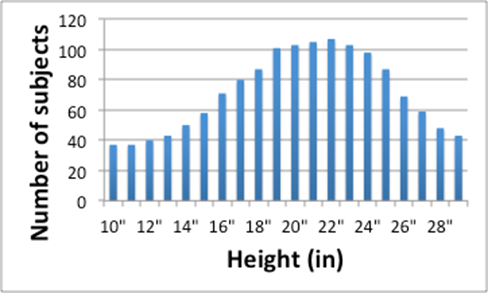The Impact of Transfer Setup on the Performance of Independent Transfers: Phase I Final Report
Adjustable height protocol
One hundred and sixteen (116) subjects were tested under this protocol and five were unable to transfer to the platform at any height in the configuration shown in (Figure 3). 92%, CI[86%,96%] of the sample (107/116) could transfer at a height of 22” (50.8cm). Fewer numbers of subjects could transfer above and below this height (Figure 9 and Table 4).

Figure 9 . Number of subjects (y-axis) able to transfer at each height increment (x-axis).
Table 4 . Percentage of subjects that were able to attain a transfer under adjustable height protocol
| Height (in) |
% Subjects Adjustable Height |
% Subjects Side guard |
|
10 |
28% |
24% |
|
11 |
28% |
25% |
|
12 |
34% |
26% |
|
13 |
37% |
27% |
|
14 |
43% |
27% |
|
15 |
49% |
31% |
|
16 |
62% |
35% |
|
17 |
69% |
40% |
|
18 |
75% |
41% |
|
19 |
88% |
43% |
|
20 |
89% |
48% |
|
21 |
91% |
51% |
|
22 |
92% |
52% |
|
23 |
90% |
51% |
|
24 |
85% |
46% |
|
25 |
73% |
46% |
|
26 |
60% |
41% |
|
27 |
50% |
38% |
|
28 |
42% |
27% |
|
29 |
37% |
22% |
Table 4 Alternative Text Description: This table gives the percentage of subjects that were able to attain a transfer under the adjustable height protocol compared to the percentage of subjects that were able to attain the transfer with the side guard in place. There are three columns; the left one lists the transfer height in inches, the middle one lists the percentage of subjects that attained the adjustable height transfer, the right one lists the percentage of subjects that attained the adjustable height transfer with the side guard.
Table 5 contains the height differentials that subjects were able to attain. For each participant, these height differentials were calculated as the relative height difference by subtracting the maximum attainable height (high and low) to the WMD seat height. The results suggest that 2” transfer heights above and below the WMD seat height are acceptable for at least 86% of the subjects that could attain the Adjustable Height protocol.
Table 5 . Percentage of subjects that were able to attain step heights.
| Relative Heights (in) |
Attainable (%) |
|
-6 |
57% |
|
-5 |
64% |
|
-4 |
69% |
|
-3 |
78% |
|
-2 |
86% |
|
-1 |
96% |
|
0 |
96% |
|
1 |
94% |
|
2 |
89% |
|
3 |
76% |
|
4 |
63% |
|
5 |
51% |
|
6 |
43% |
Table 5 Alternative Text Description: This table gives the percentage of subjects that were able to attain step heights. There are two columns; the left one lists the relative heights attained in inches, the right one lists the percentages of subjects that were able to attain that height.
Subjects that could not attain the protocol
In addition to the 4 subjects that could not attain any of the protocols, two additional subjects (1 woman, 1 man) could not attain the adjustable height protocol. The woman was 51 years old and had a an incomplete spinal cord injury at level L4, weighted 170 lbs, was 64” tall, and had been using a manual wheelchair for one year. The man was 68 years old and had a complete spinal cord injury at level T2, weighted 185 lbs, was 71” tall, had been using a manual wheelchair for 7 years, and used a walker to aid with his transfers.
Subjects that could not attain the protocol
In addition to the 4 subjects that could not attain any of the protocols, two additional subjects (1 woman, 1 man) could not attain the adjustable height protocol. The woman was 51 years old and had a an incomplete spinal cord injury at level L4, weighted 170 lbs, was 64” tall, and had been using a manual wheelchair for one year. The man was 68 years old and had a complete spinal cord injury at level T2, weighted 185 lbs, was 71” tall, had been using a manual wheelchair for 7 years, and used a walker to aid with his transfers.

User Comments/Questions
Add Comment/Question